There is nothing else like Mirror’s Edge. While certain aspects of the game might seem familiar, the combination of ideas in DICE’s latest runs counter to the vast majority of titles gamers are used to. Mirror’s Edge Catalyst, a reboot of 2008’s Mirror’s Edge, is an improvement on the original in just about every way. With those very improvements however, the game also stumbles under the weight of its own ambitious goals.
As the game begins, players step into the running shoes of Faith Conners, a woman just released after being in prison for two years. Looking to get back to her old life, Faith soon rejoins the Runners, a group of roof-hopping couriers and thieves that work in the shadows of the oppressive Conglomerate-ruled society. The initial introductions out of the way, Mirror’s Edge Catalyst has you running and jumping your way across the open world of Glass in no time.
And run you certainly do. Everything in Mirror’s Edge Catalyst is built around the idea of enjoying and exploring movement. More than almost any other modern game, the emphasis is solely on transversal. While running from point A to point B might sound boring on paper, Mirror’s Edge Catalyst manages to make even the simplest trip across the map feel engaging.
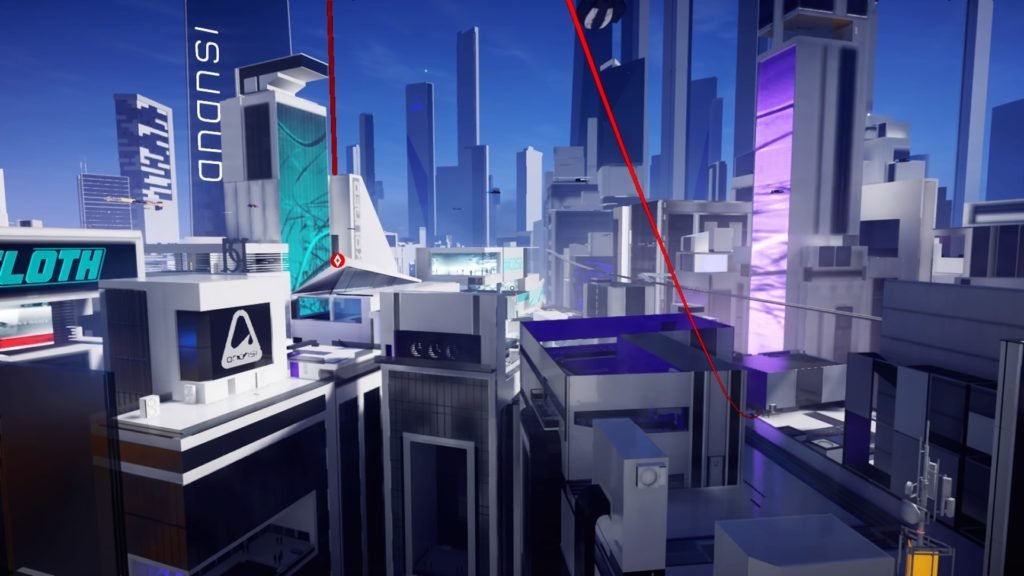
Whether you’re sliding, climbing, rolling, swinging, or vaulting, you’re always doing something. And just as importantly, every movement matters. Tap the jump button and you’ll hop over a railing. Hold the jump button and Faith uses the railing like a springboard, leaping off of it.
The complexity of the movement eventually builds to include chaining moves together. Be it combining a horizontal and then a vertical wall-run or the whole host of other options created through the game’s deceptively simple controls, each one feels great every time you pull it off.
In a similar way, Faith also acquires new gadgets and abilities throughout the game. Combining a metroidvania-style and RPG progression systems, Mirror’s Edge Catalyst slowly opens up new areas of the map. More than that, things like the ability to grapple up to certain ledges, or grapple and swing from certain objects, ups the number of ways for you to transverse the world.
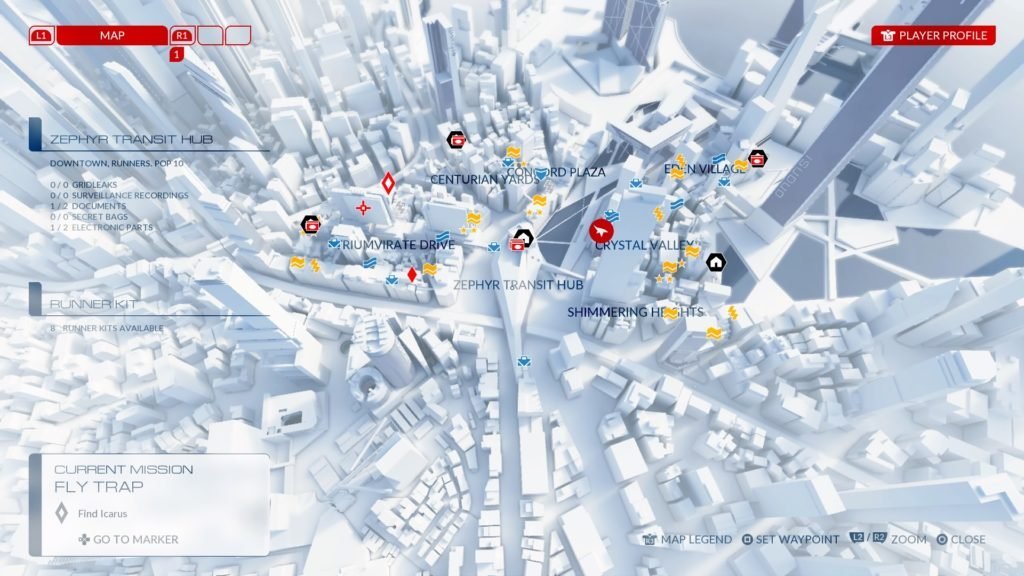
When leaping from one building to another however, even the smallest mistake usually leads to death. Thankfully the load times aren’t atrocious and the checkpoints are always just back at the last point your feet were on the ground. That said, you will die a lot. Many of the jumps take very exact timing, the kind that only comes from practice and the occasional round of trial and error.
As part of the emphasis on movement, there’s also Mirror’s Edge Catalyst’s most defining feature: you never pick up a gun. Unlike its predecessor and the bulk of the first-person games out there, using a gun isn’t even an option here. There’s still combat, but again, movement is the main attraction. As long as you keep moving, you build up your Focus Shield, which keeps bullets from hurting you. Stumble, fall, or stop and that shield goes away.
If you do stand and fight though, Faith can dash in any direction, allowing her to outmaneuver her opponents. Combine this with the facts that her attacks can be directional and you can utilize the environment to your advantage, and you end up with quick, tight scuffles where positioning and awareness are just as important as getting in as many kicks as possible.
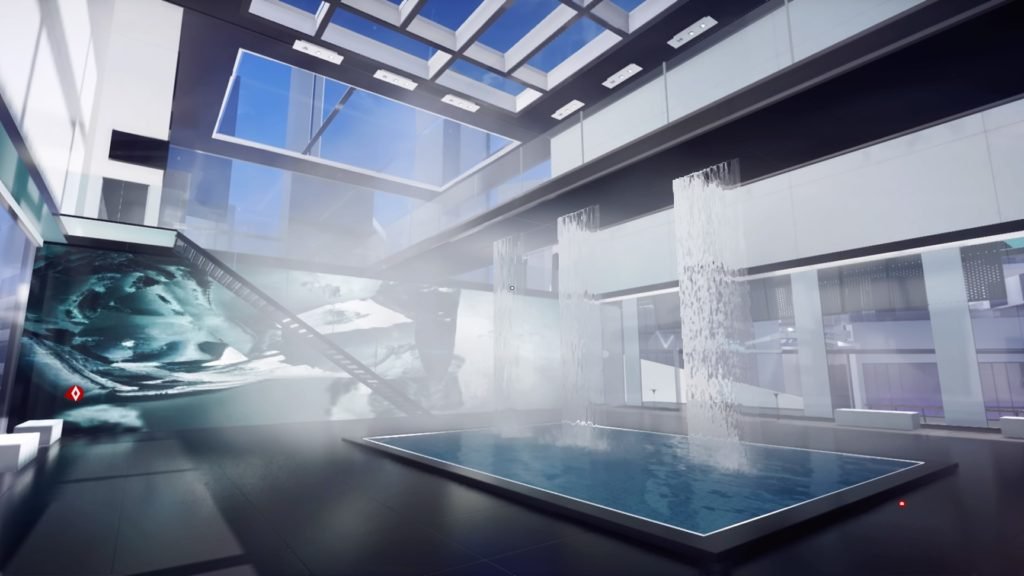
Mirror’s Edge Catalyst nails everything it sets out to do when it comes to gameplay mechanics. Moment-to-moment, racing through Glass is a blast. Unfortunately, it’s in many other aspects that the game misses a few beats.
The best parts of Catalyst hinge on understanding the tools you have, reading the environment, and figuring out how to use those tools. This idea of the environment being almost a puzzle to conquer is front-and-center in the game’s 15 main story missions, each one usually taking you to a new, visually striking interior not available in the larger open world. It’s also the entire idea behind a few of the side activities.
The game’s four GRIDNODE side missions for instance are devilish, massive platforming puzzles that unlock the ability to fast travel around the map. Likewise, you can climb up to and hack billboards around the city to showcase your own personalized insignia. In both cases, the usual directional aid “Runner’s Vision” is turned off and you have to figure out the path on your own.
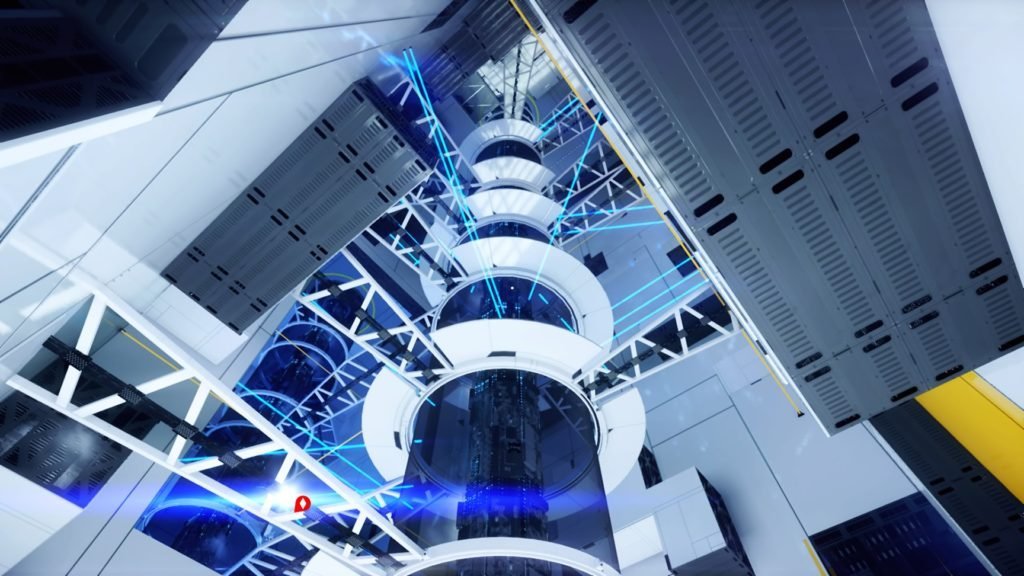
In contrast, other activities in the game aren’t quite as clear-cut. Mirror’s Edge Catalyst will freely show you the path, but that path usually isn’t the fastest way to get where you’re going. It’s up to the player to find and use shortcuts that the game doesn’t simply show you.
This is a massive part of Dashes, Catalyst’s built-in time trials. Like you’d expect of time trials, Dashes clock how long it takes you to reach the end of a particular course. There are three- two- and one-star times to beat for each one, and your best time ends up on the online leaderboards. The path the game shows you to reach the objective however, usually only gets you there fast enough to net a single star.
Almost every Dash instead relies on figuring out a trick. In some cases it’s as simple as grabbing an unmarked zipline, while in many others it actually involves taking a completely different, unmarked path. This can be incredibly frustrating at first, running the course perfectly but still coming in a minute above some of the best times. Once you begin to look for these tricks however, a cadence begins to set in.
I found myself running a course once to find the end point, and then a second, third, and maybe even forth time, not worrying about the clock, but instead slowly exploring different possibilities. Only then, once I had figured out the best path, did I begin to actually run for a best time.
This strategy works for the Dashes, but for every activity that allows you to explore and understand the environment, there’s another that doesn’t. These just put you under a clock, counting down instead of up.
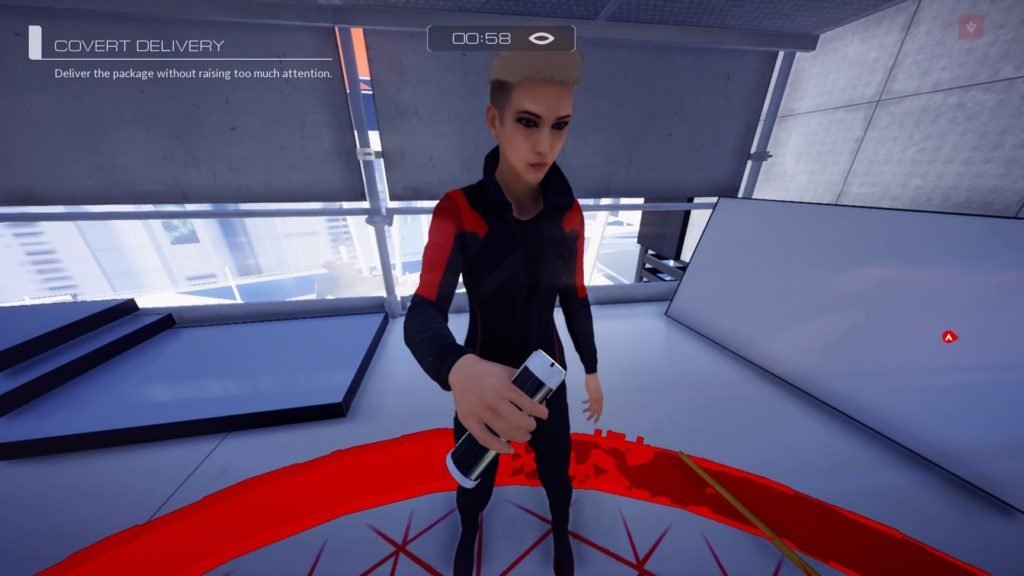
Delivery missions see people hand you the same identical vial every time and run it across the city, while Distraction missions ask you to run through different groups of enemies. Both are given a time limit however, and annoyingly, the path the game shows you, even if run perfectly, might not get you there before the clock hits zero.
Being on a time limit alone would be enough to hamper methodical exploration. On top of that, the fact that you have no way of knowing where the end point is without getting to it, while the same character dialogue plays over the run every single time you fail and have to restart, the activities become much more of a chore than they ever should be.
Missing common sense features then only exasperate these design problems further. The game never displays the distance to your target. When the clock hits zero on a Delivery, unless you can actually see the finish line, there is no way of knowing if it was around the next corner or three rooftops over. Likewise, the game does’t list what times you need to beat to get stars in the Dashes.
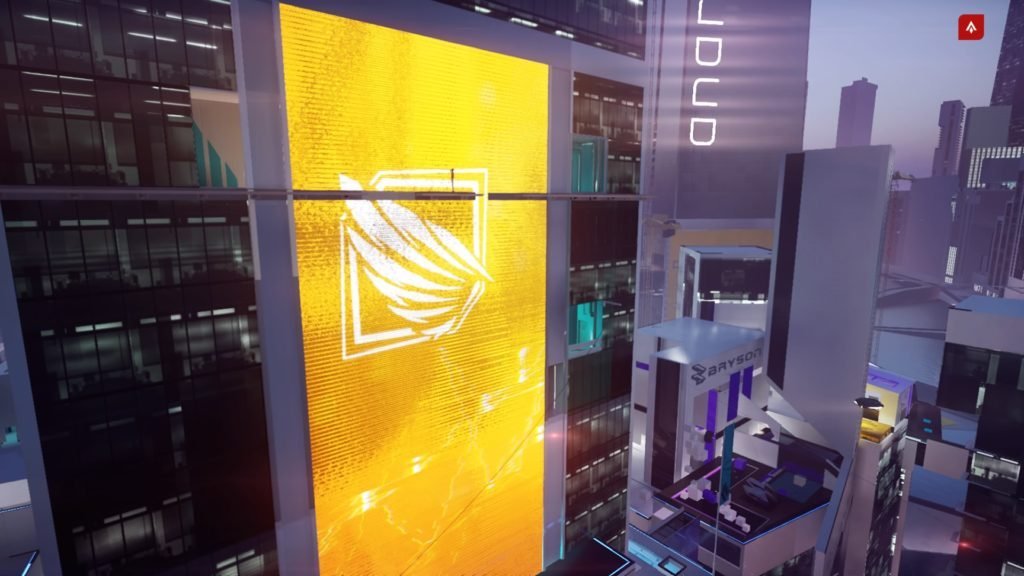
These sort of missing feature pieces even extend into the social elements dotted throughout the game. As mentioned before, you can hack into billboards and other screens, making them display your insignia. That insignia will then be visible in the games of your friends. In order to customize it though, you’re forced to either get the Mirror’s Edge Catalyst App or go to the official website.
There’s also user generated content in the form of Time Trials and Beat L.E.s. At any point in the open world you can make a Time Trial course from the pause menu. You can place multiple waypoints and a finish line, and then publish it, allowing it to show up for other players. Unfortunately, there’s currently no curation system. If you run a course and find it to be poorly designed and not very fun, there’s no rating system allowing you to say so.
In a similar way, Beat L.E.’s are essentially points of interest. It’s clear the thought behind them was to allow players to mark hard to reach places, a challenge for others to reach the same point. But the ability for any player to put one down anywhere leads to them simply cluttering the map with no real purpose. And while not necessarily a bad thing, that role is already taken by Catalyst’s hundreds upon hundreds of collectibles.
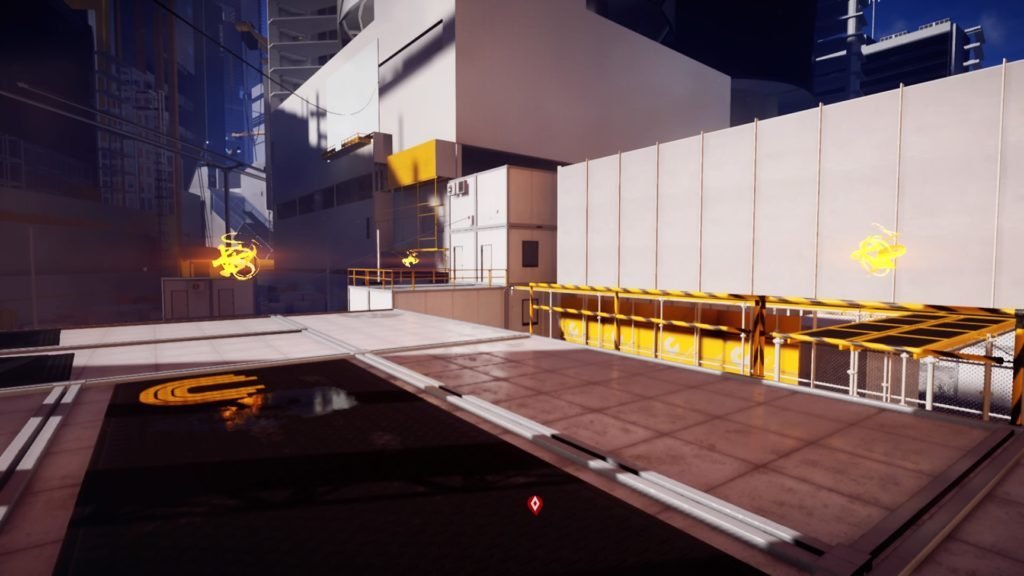
Not counting the 87 surveillance recordings and documents, most of which have actual narrative value, there are a staggering 615 GridLeaks, Electronic Parts, and Secret Bags to collect. All three types of collectibles have no value within the game other than a tiny amount of experience.
GridLeaks (floating orbs you just have to run through) and Electronic Parts (panels you have to run up to and hit a button) both give 10 EXP each, Secret Bags giving 25. In comparison, punching a security officer and running away without dying is usually good for a hundred. While having the collectibles there does add a lot more to do in the open world, it’s unfortunate they don’t have a greater payoff in terms of gameplay or narrative.
And finally that does bring us to the game’s narrative. Mirror’s Edge Catalyst takes place in a world where capitalism has gone horribly wrong. Long ago a small group of families orchestrated an overthrow of a communist golden age. In its wake, those families forged a new nation, Cascadia, and rose as corporate dynastic monarchs. Ever since, they have ruled a splintering society based on caste and corporate fealty, doing their best to blind their citizens to the theocratic nation at one border and the lingering communist one at the other.
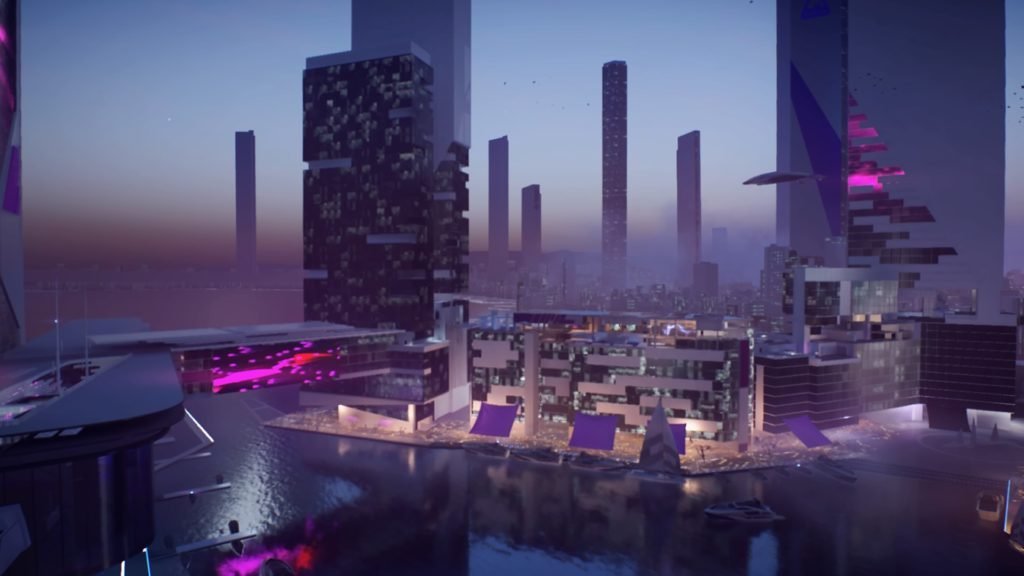
It’s a fascinating premise, and absolutely a world worth exploring. But all of that is hidden away in those 87 narrative collectibles. Little, if any of it, actually comes through in the course of the game. While it has an amazing foundation, Mirror’s Edge Catalyst just doesn’t do enough to develop and convey its story to the player.
For example, much of the narrative revolves around something called Reflection. Early in the game, Faith finds a “blueprint” for it. Even while everyone knows what Reflection is, and discusses it at length, the game never bothers to actually explain it to the player until roughly two-thirds of the way through the story.
Ultimately, when it comes to telling the player anything, the narrative sadly feels a bit sloppy. There’s an audio diary you can find and listen to that spoils a massive plot twist a full mission before it happens. But during that mission, Faith still has no clue what’s coming. Couple things like this with uneven voice performances, and it becomes hard to ever really attach to the narrative.
As fun as it is to play, Mirror’s Edge Catalyst does have its faults. And even if it didn’t, it still wouldn’t appeal to every gamer. At its core though, the game is about the joy of sprinting across the rooftops, and feeling that sense of fantastic movement. In both cases, DICE did exactly that, making Mirror’s Edge Catalyst well worth it for any fan of the original or anyone looking for something radically different from the norm.

